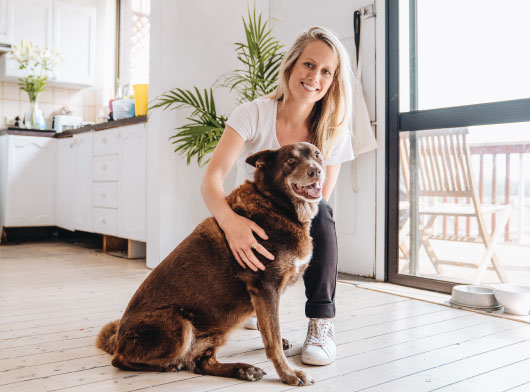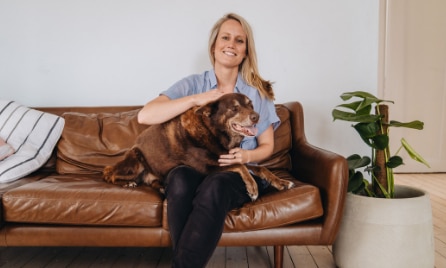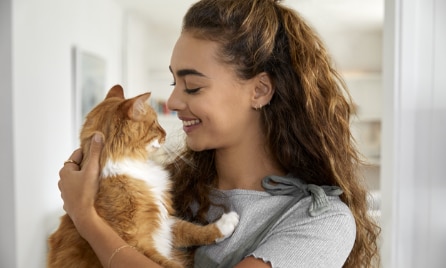- text
-
† Offer available to new Everyday Pet Insurance policyholders, and is limited to 1 membership per eligible policy. The free membership offer (valued at $199p.a) is from the date of your policy commencement, provided your Everyday Pet Insurance policy remains active. You are not eligible to redeem the free membership subscription for cash or credit. VetAssist is a separate subscription based service to the Everyday Pet Insurance product, and is provided independently by Everyday Insurance third party service provider, VetChat Services Pty Ltd (VetChat). Click here for full VetAssist Service terms and conditions. Everyday Insurance reserves the right to vary or remove this offer at any time and will provide reasonable notice of any such changes.
Tips if your pet is experiencing separation anxiety.
After many months of spending more time at home with our pets, this has become their new normal. Regardless of whether your pets have been part of the family for some time prior to COVID-19, or if they joined the family during and have not known life any other way, changes to restrictions in the future will mark a sudden and impactful change in your pet’s life.
Some pets will take this in their stride, while others will find it harder, and you may see some signs of separation related distress.
So how can you help them cope well when spending time alone?
1. Start to introduce some alone time.
Now is the time to start spending some time away from your pets where possible. Techniques include:
Moving out of your pet’s direct line of sight.
Spending time apart in a different room.
Taking short trips outside whilst they remain at home.
It is important to slowly increase your distance and/or time away from your pets so they can become confident and relaxed with the gradual changes.
2. Make sure the alone time is fun.
Encourage your pets to have fun whilst they are home alone. We want to give them amazing things to do when they are not directly with you, to create positive associations. Food rewards suit most pets, so on departure consider giving your pet a filled with appropriate treats; they won’t even know you’re gone!
You can start to introduce some activities as well, such as hiding a chew toy filled with treats and teaching them to find it. You can start making the toy very easy to find, and gradually make it more difficult for them to locate it. This is more suitable for a single dog home, as there is a risk of fighting over the prize in a multi-dog home.

With cats, ensure they have multiple places to hide (e.g cardboard boxes) and climb; get creative and utilise the vertical space in your home.

3. Know the signs of distress and monitor for them.
There are many ways that a pet who is home alone might show you that they are experiencing separation related distress. Depending on the severity, pets may:
Plant
Salivate
Pace around the house
Vocalise
Urinate or defecate inside
Perform destructive behaviours (e.g. scratching doors, chewing at bedding)
Video monitoring is a great way for you to see exactly what your pet gets up to and how they are coping when they are alone. There are many options on the market for this; you can purchase and install a pet camera that you can monitor remotely, or look for a dog monitoring app where no hardware is needed to be purchased, but may require two devices.
4. Seek Veterinary help.
The signs of distress above can also be attributed to medical problems and other causes of anxiety. First thing to do if you are seeing these signs with your pet is to consult your Vet. Underlying medical problems need to be treated, and for severe anxiety - medication and supplements may be prescribed in addition to a behavioural plan.
Related articles.
VetAssist Vets are not able to prescribe medication or provide you with any information about your insurance policy. Any consultations with VetAssist Vets does not guarantee an approved claim. In the event of an emergency, you should contact your Vet immediately.
- text
-
Everyday Pet Insurance policies entered into for the first time prior to 17 July 2023 and subsequent renewals of those policies are issued by The Hollard Insurance Company Pty Ltd ABN 78 090 584 473, AFSL 241436 (Hollard), arranged and administered by PetSure (Australia) Pty Ltd ABN 95 075 949 923, AFSL 420183 (PetSure) and promoted and distributed by Hollard’s Authorised Representative (AR) Woolworths Group Limited ABN 88 000 014 675, AR 245476 (Woolworths). Everyday Pet Insurance policies entered into for the first time on or after 17 July 2023 and subsequent renewals of those policies are issued by PetSure and promoted and distributed by PetSure’s AR, Woolworths. Any advice provided is general only and does not take into account your individual objectives, financial situation or needs. Please consider the Product Disclosure Statement (PDS) to ensure this product meets your needs before purchasing, or choosing to continue with the product. PDS and Target Market Determination available at insurance.everyday.com.au/pet-insurance.





